Deportes Tolima are currently in the midst of a terrific season. At the end of Colombia’s Liga Dimayor Apertura, they finished second, level on points with surprise winners Atlético Bucaramanga and only behind by one goal on goal difference.
Tolima’s improvement is extremely commendable, given they finished last season’s Apertura in 13th place. They then shot up to fourth place in the Clausura, courtesy of hiring former Manchester City U21s and Brighton & Hove Albion goalkeeper David González. González has proven to be a shrewd addition, leading them to 11 wins in 20 league matches last season (four draws, five losses) and repeating that this year in 19 matches (five draws, three losses).
In last season’s Clausura, Tolima began crossing the ball with better accuracy, while their corners also began troubling opponents a lot more. That has been the case once again this season, and with more time to understand González’s demands from these situations, they seemed to have improved even further on that front.
This tactical analysis will take a look at statistics to analyse those two primary modes of attack, key players within González’s tactics and provide analysis of some examples to better understand how these situations work.
Background
González enjoyed a 20-year career as a player, having begun his journey with Independiente Medellín after graduating from their academy in 2000. After six years with the first team, he moved to Deportivo Cali and Caykur Rizespor in quick succession before spending a six-month period without a team.
In February 2009, he was picked up by Huracán but was without a club once again from that summer until January 2010, when Manchester City signed him. González never played for their first team, instead enjoying loan spells at Leeds United and Aberdeen before joining Brighton on a free transfer in January 2012.
Seven months later, he moved on to another Bosman move to Barnsley before returning to Colombia with Deportivo Pasto. A few more short spells with Rionegro Águila, Independiente Medellín (on loan) and Deportivo Cali followed before he hung up his boots in 2021.
Following his retirement, González got into management, securing his first gig with Medellín in June 2022. He remained in the role for nearly a year, guiding them to 22 wins and 17 draws in 56 matches before departing in May 2023.
In September last year, the now 41-year-old took up his current role at Deportes Tolima.
What does the data say about Deportes Tolima’s attack this season?
On a surface level, Tolima’s attack has enjoyed plenty of success this season. They are averaging 1.39 expected goals (xG) per game and marginally outperforming that with 1.48 goals scored, which suggests that their goalscoring rate is sustainable. They are attempting 12.58 shots per game, getting a decent 37.9% of those on target. Their shooting from outside the box hasn’t been great, with only 26.1% of their 5.52 attempts per game on target.
Among their passing stats, what has stood out is their accuracy on long passes, as they get 56.7% of their long-ball attempts to a teammate. Their forward passing (75.9% accuracy on 136.54 attempts per game) is more than healthy as well. Their final third passing (74% accuracy on 49.19 attempts) and progressive passing (73.5% accuracy on 69.54 attempts) have been solid, too.
Where they really differentiate themselves from most of the league is in their effectiveness from crosses. As the scatterplot below consisting of the corners attempted and percentage of corners leading to a shot indicate, they maintain a solid accuracy (38%) despite their high volume (4.58) in a league where most teams have managed only one of the two.
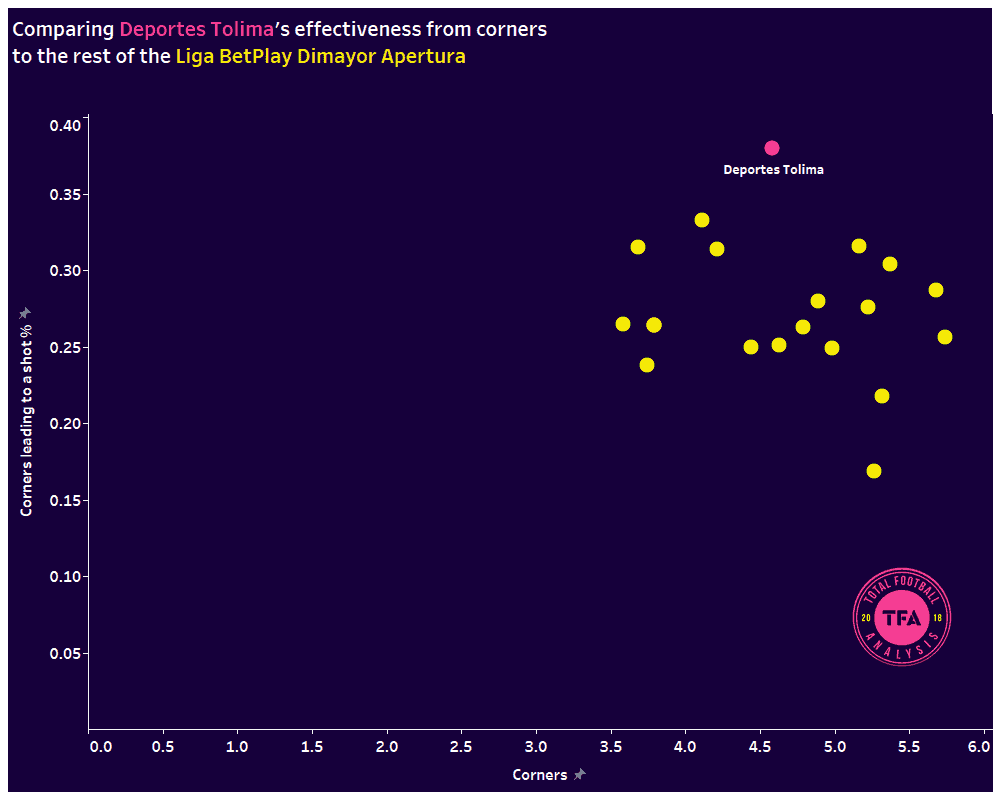
For instance, América de Cali attempt 5.74 corners per game, but have an accuracy of just 25.6%. The closest in accuracy to Tolima are Boyacá Chicó at 33.3%, but their corners per game is also lower at 4.11. Tolima have thus simply been a class apart in this regard this season.
The second but less obvious manner in which González’s team have differentiated themselves from the rest of the pack is with respect to crosses. Here, there are a few teams that are doing marginally better than Tolima; however, as the scatterplot below shows, they are once again managing high accuracy at a high volume.
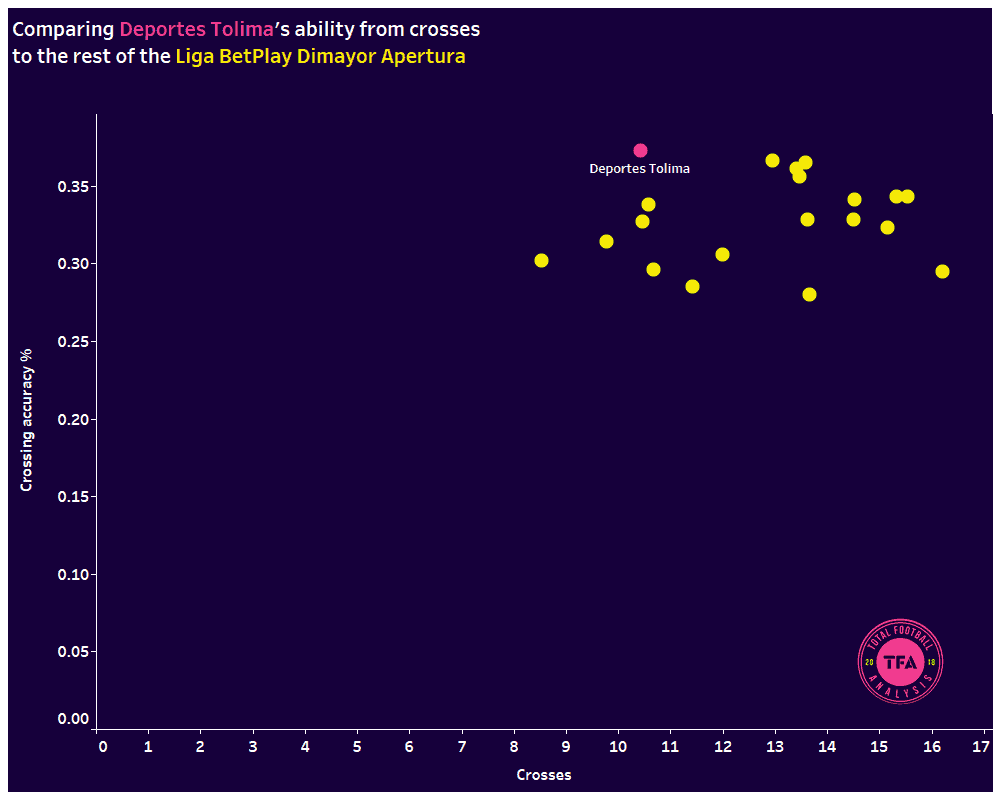
In this scenario, Tolima (10.42 crosses per game) are outperformed in volume by 17 of the 20 teams in the league, with Once Caldas (16.21), Santa Fe (15.53) and Atlético Nacional (15.32) in particular some distance ahead. However, Tolima lead the league in accuracy alongside La Equidad and América de Cali at 37%.
These two have been Tolima’s two main contributors in attack. They are also a solid counterattacking side, with 41.7% of their 1.63 counterattacks per game ending in a shot. However, that places them only in the middle of the pack in the league.
For context, toppers Atlético Bucaramanga averaged 2.00 counterattacks per game, with 45.5% of those ending in a shot. La Equidad, who finished fifth, recorded 1.89 counterattacks per game, of which 44.4% ended in a shot. Even Deportivo Cali, who finished 15th, had 1.79 counterattacks per game, with 38% ending in a shot.
Crosses
When it comes to crossing, Tolima enjoyed equal success from both flanks, as the map below shows. Álex Castro, who largely played down the left wing but also featured on the right, averaged 3.24 crosses per game with 46.3% accuracy. In contrast, Jeison Lucumí, capable of operating on either flank as well, averaged 1.34 crosses per game, 45.5% of which were accurate. Kevin Pérez, who predominantly featured on the right, averaged 1.44 crosses per game with 35.3% accuracy.
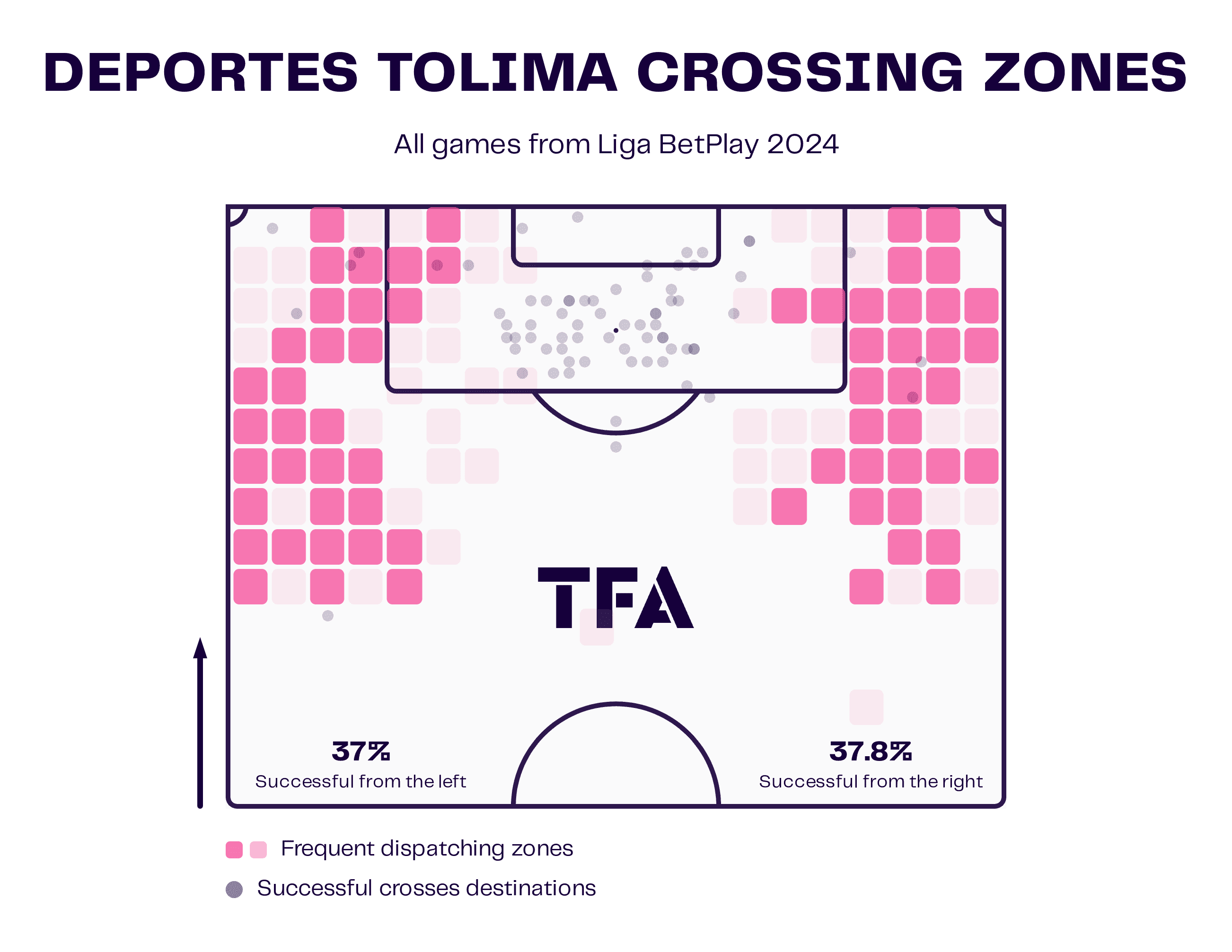
Castro’s biggest strength is his ability to cross with either foot, making him a threat regardless of which wing he plays in. As the clip below shows, this often confuses the full-back (marked in pink) defending him as he struggles to close down either foot, while Castro (marked in black) displays fantastic skill to turn him inside out and get to the by-line to deliver a cross.
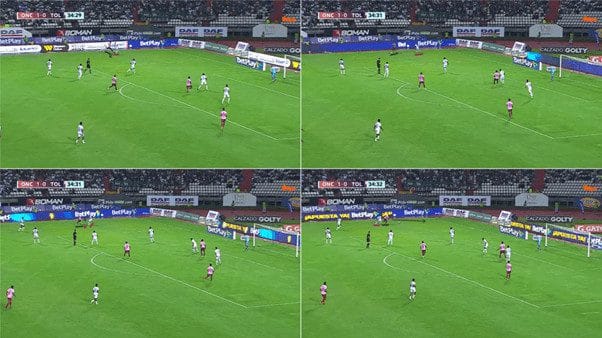
What is also noticeable in this photo is how the three Tolima players in the box position themselves. Given the gaps between the Once Caldas defenders, the centre-forward stays between the two centre-backs; one player is open at the far post, and the third is preparing for a run to the near post in another gap between the defenders.
When it comes together for Castro, he can deliver the killer blow, as he does below for Brayan Gil (marked in black) to score. The latter curving his run brilliantly to get ahead of the defender and head the ball home.
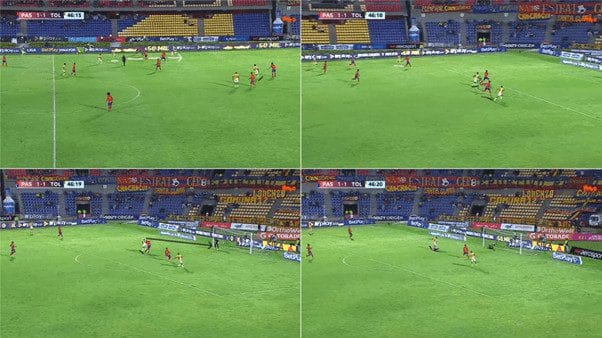
While the volume of crosses from the right typically feels lesser, they were still an effective attacking avenue for Tolima. In this clip below, they hit Deportivo Pasto on the counter with a cross from Facundo Boné, another winger capable of manning either flank. Boné receives a ball over the top from the left before floating a cross in for Lucas González to fire home at the far post.
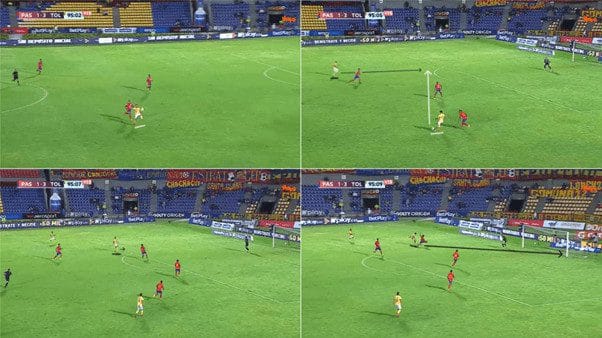
Corners
Interestingly, Tolima did not score from a corner during the Apertura. However, the patterns of play that developed from these situations leads us to believe that they could eventually become a big weapon in their armoury. González’s men have variety in the way they attack corners, which helps them keep opponents guessing.
Consider the sequence below from their match against Atlético Nacional. Tolima’s players eventually all jostle with their opposing numbers for space, but when the ball prepares to come in, we see one player move to the far post, one dart to the near-post, and three remain near the penalty spot. Almost all five players have found a way to gain some separation from their markers.
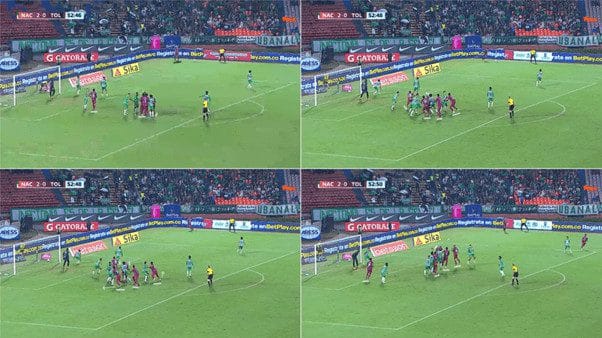
Where they err here is by the front-post runner pausing his run and the two central attackers staying too close to each other. If these players fan out a little more, there’s a good chance a loose ball could fall to them. As we see, there is an open space in the box on the bottom-right tile that goes unused.
In this sequence against Santa Fe, however, they space themselves out better. Here, one player blocks a defender’s path while the other three rush to the near-post in unison before joining them, leaving just one man behind. The last man gets ahead of his marker, but his header is poor and balloons over the bar.
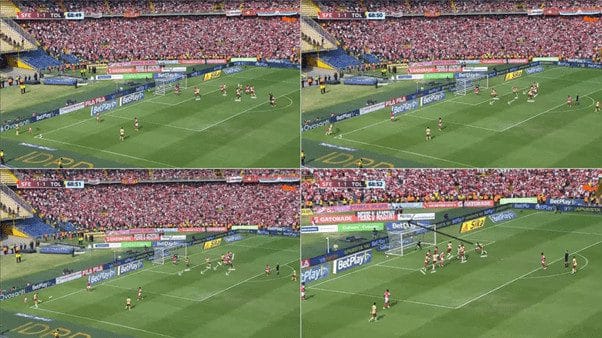
These near-post runs are an important feature of Tolima’s corner play as they work in two more ways apart from the one mentioned above. The first of those becomes evident in the sequence below from their match against Junior FC, where the cross is diverted towards goal from the near-post, but the opposing goalkeeper reacts brilliantly to tip it over.
Notice how all the players in the box initially start from close to the penalty spot. With the opponents deploying more of a zonal marking system, Tolima, who commit only four players this time, don’t have to move too much inside the area to find space.
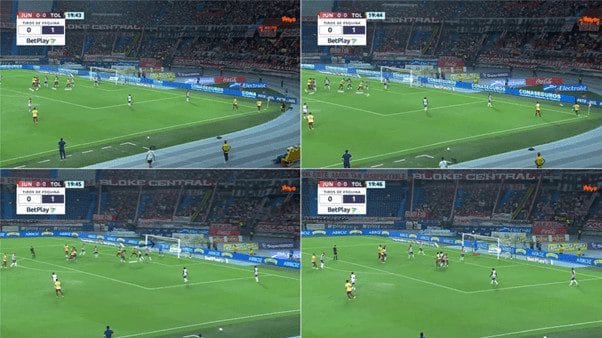
The other way they use the near-post run is to flick it onto the back-post, as they do below against Patriotas Boyacá. Notice how two of Tolima’s players block off the central area to enable a free run to the back post while they knowingly deploy a player shorter than his marker at the front post to enable a flick-on and a decoy at the back post who stands still and doesn’t try to receive the ball. These players play their role to perfection, but unfortunately, the finish is a poor one and goes wide from seemingly unmissable range.
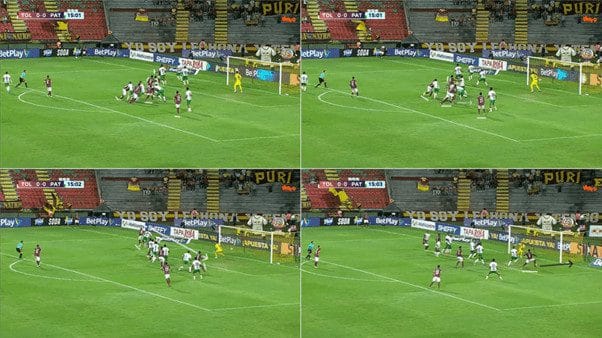
Lastly, Tolima have some innovative corners up their sleeve, such as this one against Bucaramanga. Here, the corner is played behind the players in central areas, who all start from the edge of the box but move closer to the goal to open up space for the man running in from behind his marker at the back-post. He takes the shot on the volley from just behind the penalty spot, but it flies over the bar.
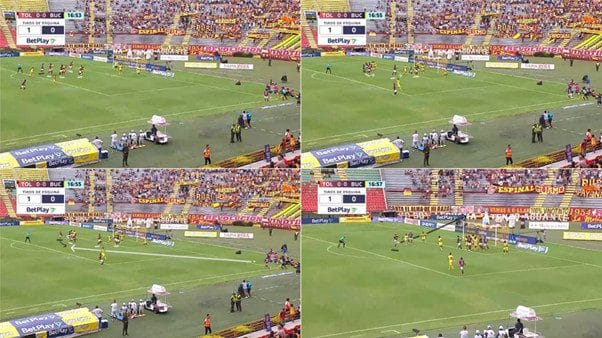
In many of these situations, Tolima have been let down by their finishing. If Yeison Guzmán, the corner-taker in most of these situations, would have had far more than two league assists had some of these had been finished. It’s worth noting that Guzmán himself has been fairly clinical, racking up eight goals to end up as their top-scorer.
Conclusion
Deportes Tolima provide a fascinating case of how teams can use crosses and corners to elevate their attacking play. David González has trained his men to use their deliveries from wide areas in a multitude of ways both from live-ball and dead-ball situations, making them a difficult team to defend.
Tolima’s finishing from corners hasn’t been the greatest. However, the signs are promising, and the expectation is for them to start scoring from these chances in due course.





Comments